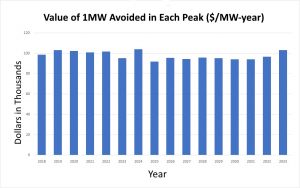22 Feb Global Adjustment Changes and How it can Help Businesses
Global Adjustments Changes and How it can Help Businesses
What is the Global Adjustment?
Every month there is a certain amount of money that the province has to pay for electricity generation. This cost includes Ontario Power Generation’s regulated nuclear and hydro generation, IESO contracts with generators and suppliers of conservation, and contracted rates administered by the Ontario Electricity Financial Corporations paid to existing generators[1]. The GA amount is this cost minus the amount covered by the Hourly Ontario Electricity Price (HOEP). The GA changes every month because generator production varies from month to month and so does the HOEP.
The GA cost is distributed among consumers in two ways. First, Class A consumers pay their portion depending on the percentage of Ontario’s total electricity they used during the 5 peak hours of the previous year. Second, after the Class A consumers have paid, the rest of the cost is distributed among Class B consumers based on how much energy each customer used in the month.
The chart below show the projected yearly GA cost for the entire year for the next 15 years.
What is Changing?
Effective January 1, 2017, the Ontario government changed the Global Adjustment (GA) regulation[2]. The most significant change to the GA is who is eligible to register as a Class A customer. Class A used to be open only to industrial customers in prescribed sectors with an average monthly peak demand more than 3 MW; the eligibility rules have now been significantly lowered. Under the new GA regulations, Class A customers can now include businesses from any sector- commercial and industrial- with average monthly peak demand of 1 MW or greater. The IESO’s website and the Government of Ontario have more specific details about the new regulation.
The Benefits of Being a Class A Customer
Class A customers are allocated GA based on the amount they consume during the top 5 peak hours of the year. This means that if a company lowers consumption during peak hours, the GA on their bill for the following year will be lower.
How it Works
For a customer new to Class A, the base line will be met by measuring hourly electricity consumption from May 1, 2016 to April 30, 2017. During the “Base Period” (the May to April period when consumption is being measured) the IESO will determine what percent of Ontario’s total electricity is used by each Class A consumer during the 5 hours of highest demand throughout the whole year. This percentage becomes the company’s “Peak Demand Factor,” the percent of the GA cost that they will pay each month of the “Adjustment Period,” from July 1, 2017 to June 30, 2018.
The GA cost for all of Ontario varies from month to month, but it is paid first by Class A consumers. Everything that is not paid for by the Class A consumers is distributed among the Class B consumers (those using less than 1MW per hour).
Using our projections of GA (from the previous chart), the following chart projects how much money a company can save each year by reducing by one MW during the five peak hours of the previous base period.
How to Become a Class A customer
Companies with an average monthly peak demand greater than 1 MW but less than 5 MW need to apply individually to be a Class A customer. By May 31, all companies that are eligible to be registered as a Class A member should have been notified by their Local Distribution Company. They have until June 15 to notify their local distributer that they wish to opt-in to Class A starting July 1, 2017. Any companies with an average monthly peak demand greater than 5 MW during the 2016-2017 Base Period, automatically will be included in Class A unless they wish to opt out. The deadline for >5MW customers to opt out is June 15.
Application process details will be provided by a customer’s Local Distribution Company, outlineing what customers need to do to opt into Class A. Some LDCs will be hosting workshops and webinars to provide extra help through the application process.
How to Increase Savings
The biggest challenge for Class A customers aiming to reduce demand during system peaks is predicting when those peak hours are likely to happen. The IESO provides information on peak-to-date in a Base Period, but the actual energy consumption numbers used to calculate a company’s Peak Demand Factor are published only after the fact. This is because it reflects the adjusted net consumption by customers, accounting for loss and embedding generation. This is where Powerconsumer can help. Powerconsumer provides an inexpensive service; we monitor the energy sector and can forecast when peak hours are coming. We warn Class A consumers about the peak hours before they occur so that the consumer can lower their consumption to reduce their rates for the future. Powerconsumer takes the guess work out of your energy consumption.
[1] IESO, 2017. Global Adjustment. http://www.ieso.ca/Pages/Ontario’s-Power-System/Electricity-Pricing-in-Ontario/Global-Adjustment.aspx
[2] Government of Ontario, 2017. Ontario Regulation 429/04. http://www.ontario.ca/laws/regulation/040429



Pingback:Powerconsumer Inc. | The Class A Opt in Period Has Passed: Where do we go from here?
Posted at 14:01h, 20 June[…] more information about GA and the industrial conservation initiative please see our other reports. Global Adjustment Changes and How it can Help Businesses and To “A” or not to “A”: Is Switching to Class A the Right Choice for Your […]
Mandy Jagt
Posted at 18:18h, 16 AugustThere have been additional changes to the ICI requirements to include industrial consumers of 500 kW and higher. Consumers between 500 kW and 1 MW are only eligible if they fall under manufacturing, industrial, or greenhouse NAICS codes.
Pingback:Are Energy Storage Batteries the Right Choice for your Business? | Powerconsumer Inc.
Posted at 02:23h, 08 May[…] a possible mechanism for critical peak avoidance, allowing for Class A consumers to reduce their Global Adjustment […]